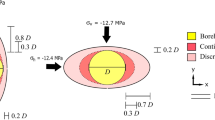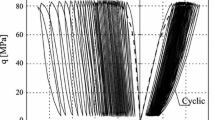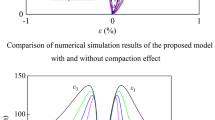Abstract
The strength decay that occurs in the post-peak stage, under low confinement stress, represents a key factor of the stress–strain behaviour of rocks. However, for soft rocks this issue is generally underestimated or even neglected in the solution of boundary value problems, as for example those concerning the stability of underground cavities or rocky cliffs. In these cases, the constitutive models frequently used in limit equilibrium analyses or more sophisticated numerical calculations are, respectively, rigid-plastic or elastic–perfectly plastic. In particular, most of commercial continuum-based numerical codes propose a variety of constitutive models, including elasticity, elasto-plasticity, strain-softening and elasto-viscoplasticity, which are not exhaustive in simulating the progressive failure mechanisms affecting brittle rock materials, these being characterized by material detachment and crack opening and propagation. As a consequence, a numerical coupling with mechanical joint propagation is needed to cope with fracture mechanics. Therefore, continuum-based applications that treat the simulation of the failure processes of intact rock masses at low stress levels may need the adoption of numerical techniques capable of implementing fracture mechanics and rock brittleness concepts, as it is shown in this paper. This work is aimed at highlighting, for some applications of rock mechanics, the essential role of post-peak brittleness of soft rocks by means of the application of a hybrid finite–discrete element method. This method allows for a proper simulation of the brittle rock behaviour and the related mechanism of fracture propagation. In particular, the paper presents two ideal problems, represented by a shallow underground cave and a vertical cliff, for which the evolution of the stability conditions is investigated by comparing the solutions obtained implementing different brittle material responses with those resulting from the assumption of perfectly plastic behaviour. To this purpose, a series of petrophysical and mechanical tests were conducted on samples of soft calcarenite belonging to the Calcarenite di Gravina Fm. (Apulia, Southern Italy), focusing specific attention on the post-peak behaviour of the material under three types of loading (compression, indirect tension and shear). Typical geometrical features representative of real rock engineering problems observed in Southern Italy were assumed in the problems examined. The numerical results indicate the impact of soft rock brittleness in the assessment of stability and highlight the need for the adoption of innovative numerical techniques to analyse these types of problems properly.






















Similar content being viewed by others
References
Andriani GF, Walsh N (1998) Caratteri tessiturali e resistenza al taglio diretto di calcareniti tenere e porose. GEAM 93:35–42 (in Italian)
Andriani GF, Walsh N (2002) Physical properties and textural parameters of calcarenitic rocks: qualitative and quantitative evaluations. Eng Geol 67:5–15
Andriani GF, Walsh N (2003) Fabric, porosity and water permeability of calcarenites from Apulia (SE Italy) used as building and ornamental stone. Bull Eng Geol Environ 62:77–84
Andriani GF, Walsh N (2007) The effects of wetting and drying, and marine salt crystallization on calcarenite rocks used as building material in historic monuments. Geol Soc Lond Spec Publ 271:179–188
Andriani GF, Walsh N (2010) Petrophysical and mechanical properties of soft and porous building rocks used in Apulian monuments (south Italy). Geol Soc Lond Spec Publ 333:129–141
Azzaroli A (1968) Studi illustrativi della Carta Geologica d’Italia. Formazioni Geologiche. Servizio Geologico d’Italia 1:183–185 (in Italian)
Backers T, Stephansson O (2012) ISRM suggested method for the determination of mode II fracture toughness. Rock Mech Rock Eng 45:1011–1022
Bishop AW (1967) Progressive failure—with special reference to the mechanism causing it. In: Proceedings of the geotechnical conference Oslo (Norway), pp 142–150
Borja RJ, Regueiro RA, Lai TY (2000) FE modelling of strain localization in soft rock. J Geotech Geoenviron Eng ASCE 126(4):335–343
Cai M, Kaiser PK (2014) In-situ rock spalling strength near excavation boundaries. Rock Mech Rock Eng 47:659–675
Carranza-Torres C, Alonso E, Alejano LR, Varas F, Fdez-Manin G (2002) Elasto-plastic analysis of deep tunnels in brittle rock using a scaled form of the Mohr–Coulomb failure criterion. In: Hammah et al (eds) Proceedings of the 5th North American Rock mechanics symposium NARMS-TAC, Toronto, pp 283–293
Castellanza R, Nova R (2004) Oedometric tests on artificially weathered carbonatic soft rocks. J Geotech Geoenviron Eng ASCE 30(7):728–739
Cheon DS, Park C, Jung YB, Jeon S (2006) Modeling brittle failure of rock using damage-controlled test. In: Proceedings of the 4th Asian rock mechanics symposium, Singapore
Choquette PW, Pray LC (1970) Geologic nomenclature and classification of porosity in sedimentary carbonates. AAPG Bull 54:207–250
Ciantia MO, Castellanza R (2016) Modelling weathering effects on the mecanical behaviour of rocks. Eur J Environ Civ Eng 20(9):1054–1082
Ciantia MO, Castellanza R, di Prisco C (2015) Experimental study on the water-induced weakening of calcarenites. Rock Mech Rock Eng 48:441–461
Cundall P, Carranza-Torres C, Hart R (2003) A new constitutive model based on the Hoek–Brown criterion. In: Brummer et al (eds) Proceedings of the third international symposium on FLAC and FLAC3D numerical modelling in geomechanics, Sudbury, Canada, Balkema, pp 17–25
De Borst R, Sluis LJ, Muhlhaus HB, Pamin J (1993) Fundamental issues in finite element analyses of localization of deformation. Eng Comput 10(2):99–122
di Prisco C, Imposimato S, Aifantis EC (2002) A viscoplastic constitutive model for granular soils modified according to non local and gradient approaches. Int J Num Anal Methods Geomech 26(2):121–138
Diederichs MS (2003) Rock fracture and collapse under low confinement conditions. Rock Mech Rock Eng 36(5):339–381
Diederichs MS (2007) Mechanistic interpretation and practical application of damage and spalling prediction criteria for deep tunnelling. Can Geotech J 44(9):1082–1116
Dunham RJ (1962) Classification of carbonate rocks according to depositional texture. In: Ham WE (eds) Classification of carbonate rocks—a symposium, vol 1. American Ass Petroleum Geol, Memoir, pp 108–121
Eberhardt E, Stead D, Coggan JS (2004) Numerical analysis of initiation and progressive failure in natural rock slopes: the 1991 Randa rockslide. Int J Rock Mech Min Sci 41(1):69–87
Edelbro C (2010) Different approaches for simulating brittle failure in two hard rock mass cases: a parametric study. Rock Mech Rock Eng 43(2):151–165
Elmo D, Stead D (2010) An integrated numerical modelling-discrete fracture network approach applied to the characterisation of rock mass strength of naturally fractured pillars. Rock Mech Rock Eng 43:3–19
Ferrero AM, Segalini A, Giani GP (2010) Stability analysis of historic underground quarries. Comput Geotech 37:476–486
Fraldi M, Guarracino F (2009) Limit analysis of collapse mechanisms in cavities and tunnels according to the Hoek–Brown failure criterion. Int J Rock Mech Min Sci 46:665–673
Geomechanica Inc (2016) Irazu software, version 2.0 Tutorial Manual
Gesualdo A, Minutolo V, Nunziante L (2001) Local collapse in soft rock bank cavities. J Geotech Geoenviron Eng 127(12):1037–1041
Ghazvinian E, Perras M, Diederichs M, Labrie D (2013) The effect of anisotropy on crack damage thresholds in brittle rocks. In: 47th US Rock Mechanics/Geomechanics Symposium, San Francisco, CA, USA, ARMA 13-503
Golchinfar N (2013) Numerical modeling of brittle rock failure around underground openings under static and dynamic stress loadings. MSc Thesis, Laurentian University, Ontario (Canada)
Gui Y, Bui HH, Kodikara J (2015) An application of a cohesive fracture model combining compression, tension and shear in soft rocks. Comput Geotech 66:142–157
Hajiabdolmajid V, Kaiser PK, Martin CD (2002) Modelling brittle failure of rock. Int J Rock Mech Min Sci 39(6):731–741
Hammah HA, Yacoub T, Corkum B, Curran JH (2008) The practical modelling of discontinuous rock masses with finite element analysis. In: The 42nd US rock mechanics symposium, ARMA, 08-180
Hillerborg A, Modeer M, Petersson PE (1976) Analysis of crack formation and crack growth in concrete by means of fracture mechanics and finite elements. Cem Concr Res 6:773–782
Hudson JA (2014) Comprehensive rock engineering: principles, practice and projects. In: Rock testing and site characterization, vol 3. Elsevier, Amsterdam, p 1001
Hudson JA, Crouch SL, Fairhurst C (1972) Soft, stiff and servo-controlled testing machines: a review with reference to rock failure. Eng Geol 6(3):155–189
Iannone A, Pieri P (1979) Considerazioni critiche sui “Tufi Calcarei” delle Murge. Nuovi dati litostratigrafici e paleoambientali. Geografia Fisica e Dinamica Quaternaria 2:173–186 (in Italian)
ISRM (1978) Suggested methods for determining tensile strength of rock materials. Int J Rock Mech Min Sci Geomech Abstr 15(3):99–103
ISRM (1979a) Suggested methods for determining water content, porosity, density, absorption and related properties and swelling and slake-durability index properties. Int J Rock Mech Min Sci Geomech Abstr 16:141–156
ISRM (1979b) Suggested methods for determining uniaxial compressive strength of rock materials. Int J Rock Mech Min Sci Geomech Abstr 16(2):135–140
Kaiser PK, Kim BH (2008) Rock mechanics advances for underground construction in civil engineering and mining. In: Proceedings of KRMS 2008, Seoul, pp 3–16
Kaiser PK, Kim BH (2015) Characterization of strength of intact brittle rock considering confinement-dependent failure process. Rock Mech Rock Eng 48:107–119
Labuz JF, Shah SP, Dowding CH (1985) Experimental analysis of crack propagation in granite. Int J Rock Mech Min Sci Geomech Abstr 22:85–98
Lisjak A, Figi D, Grasselli G (2014) Fracture development around deep underground excavations: insights from FDEM modelling. J Rock Mech Geotech Eng 6:493–505
Lollino P, Martimucci V, Parise M (2013) Geological survey and numerical modeling of the potential failure mechanisms of underground caves. Geosyst Eng 16(1):100–112
Mahabadi OK, Lisjak A, Munjiza A, Grasselli G (2012) Y-Geo: new combined finite–discrete element numerical code for geomechanical applications. Int J Geomech 12:676–688
Martin CD (1997) 17th Canadian geotechnical colloquium: the effect of cohesion loss and stress path on brittle rock strength. Can Geotech J 34(5):698–725
Mateu-Vicens G, Pomar L, Tropeano M (2008) Architectural complexity of a carbonate transgressive systems tract induced by basement physiography. Sedimentology 55:1815–1848
Meng F, Zhou H, Zhang C, Xu R, Lu J (2015) Evaluation methodology of brittleness of rock based on post-peak stress–strain curves. Rock Mech Rock Eng 48:1787–1805
Munjiza A (2004) The combined finite–discrete element method. Wiley, Hoboken
Munjiza A, John NWM (2002) Mesh size sensitivity of the combined FEM/DEM fracture and fragmentation algorithms. Eng Fract Mech 69(2):281–295
Munjiza A, Andrews KRF, White JK (1999) Combined single and smeared crack model in combined finite–discrete element analysis. Int J Num Methods Eng 44(1):41–57
Parise M, Lollino P (2011) A preliminary analysis of failure mechanisms in karst and manmade underground caves in Southern Italy. Geomorphology 134:132–143
Pine RJ, Coggan JS, Flynn ZN, Elmo D (2006) The development of a new numerical modelling approach for naturally fractured rock masses. Rock Mech Rock Eng 39(5):395–419
PLAXIS-2D (2015) User’s manual. Plaxis BV, Delft
Pomar L, Tropeano M (2001) The Calcarenite di Gravina Formation in Matera (Southern Italy): new insights for coarse-grained, large-scale, cross-bedded bodies encased in offshore deposits. AAPG Bull 85:661–689
Stead D, Coggan JS, Eberhardt E (2004) Realistic simulation of rock slope failure mechanisms: the need to incorporate principles of fracture mechanics. In: Proceedings of SINOROCK international symposium on rock mechanics: rock characterization, modelling and engineering design methods. Int J Rock Mech Min Sci 41, 446
Stead D, Eberhardt E, Coggan JS (2006) Developments in the characterization of complex rock slope deformation and failure using numerical modelling techniques. Eng Geol 83:217–235
Suchowerska AM, Merifield RS, Carter JP, Clausen J (2012) Prediction of underground cavity roof collapse using the Hoek–Brown failure criterion. Comput Geotech 44:93–103
Tatone BSA, Grasselli G (2015) A calibration procedure for two-dimensional laboratory-scale hybrid finite–discrete element simulations. Int J Rock Mech Min Sci 75:56–72
Troncone A (2005) Numerical analysis of a landslide in soils with strain-softening behaviour. Géotechnique 55(8):585–596
Vasak P, Kaiser PK (1995) Tunnel stability assessment during rockbursts. In: Proceedings 3rd Canadian conference in computer applications in the mineral industry, Montreal, Quebec
Wawersik WR, Fairhurst C (1970) A study of brittle rock fracture in laboratory compression experiments. Int J Rock Mech Min Sci 7:561–575
Zhang ZX (2002) An empirical relation between mode I fracture toughness and the tensile strength of rock. Int J Rock Mech Min Sci 39:401–406
Zhao X, Cai MF, Cai M (2010) Consideration of rock dilation on modeling failure and deformation of hard rocks: a case study of the mine-by-test tunnel in Canada. J Rock Mech Geotech Eng 2(4):338–349
Author information
Authors and Affiliations
Corresponding author
Rights and permissions
About this article
Cite this article
Lollino, P., Andriani, G.F. Role of Brittle Behaviour of Soft Calcarenites Under Low Confinement: Laboratory Observations and Numerical Investigation. Rock Mech Rock Eng 50, 1863–1882 (2017). https://doi.org/10.1007/s00603-017-1188-0
Received:
Accepted:
Published:
Issue Date:
DOI: https://doi.org/10.1007/s00603-017-1188-0




